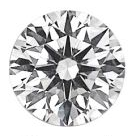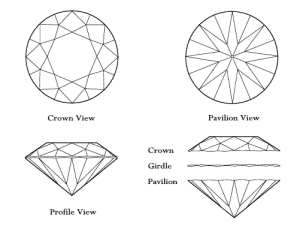Round or Brilliant Shape

Firstly, the facet pattern has been scientifically created with sparkle in mind and so it is an excellent choice if you’re looking for a really flashy stone.
Secondly, the round shape means it is classic yet versatile, suiting all types of designs in any variety of setting styles.
Facet Pattern
The brilliant cut is characterised by having 57 or 58 facets (depending on whether the cutlet is flat or not). Unbelievably, even tiny accent brilliant cut stones are cut with all of these facets too! Below is an illustration showing how the facets are divided between the crown and pavilion:
History
Brilliant cut diamonds can trace their history back to the middle of the 17th century, which is when diamond cutters began using more refined methods of cutting diamonds. The first cross-cut diamond was developed by Cardinal Mazarin in 1650 – these are known as Mazarins. By the 18th Century, this cut had been developed into what we know as “old mine” or “old European cuts”. It was not until 1919 that the Brilliant cut as we know it today was created. Originally, it was referred to as the Tolkowsky cut, named after it’s creator, Russian mathematician and diamond enthusiast Marcel Tolkowsky.

